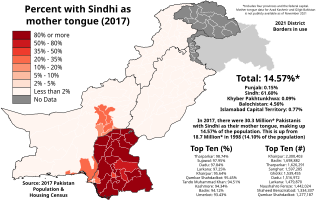Ethnologue: Languages of the World is an annual reference publication in print and online that provides statistics and other information on the living languages of the world. It is the world's most comprehensive catalogue of languages. It was first issued in 1951, and is now published by SIL International, an American evangelical Christian non-profit organization.

The Indo-Aryan languages are a branch of the Indo-Iranian languages in the Indo-European language family. As of the early 21st century, they have more than 800 million speakers, primarily concentrated in India, Pakistan, Sri Lanka, Bangladesh, Nepal and Maldives. Moreover, apart from the Indian subcontinent, large immigrant and expatriate Indo-Aryan–speaking communities live in Northwestern Europe, Western Asia, North America, the Caribbean, Southeast Africa, Polynesia and Australia, along with several million speakers of Romani languages primarily concentrated in Southeastern Europe. There are over 200 known Indo-Aryan languages.

Gujarati is an Indo-Aryan language native to the Indian state of Gujarat and spoken predominantly by the Gujarati people. Gujarati is descended from Old Gujarati. In India, it is one of the 22 scheduled languages of the Union. It is also the official language in the state of Gujarat, as well as an official language in the union territory of Dadra and Nagar Haveli and Daman and Diu. As of 2011, Gujarati is the 6th most widely spoken language in India by number of native speakers, spoken by 55.5 million speakers which amounts to about 4.5% of the total Indian population. It is the 26th most widely spoken language in the world by number of native speakers as of 2007.

Sindhi is an Indo-Aryan language spoken by about 30 million people in the Pakistani province of Sindh, where it has official status. It is also spoken by a further 1.7 million people in India, where it is a scheduled language, without any state-level official status. The main writing system is the Perso-Arabic script, which accounts for the majority of the Sindhi literature and is the only one currently used in Pakistan. In India, both the Perso-Arabic script and Devanagari are used.
The Gujarati languages are a Western Indo-Aryan language family, comprising Gujarati and those Indic languages closest to it. They are ultimately descended from Shauraseni Prakrit.

Kutchi or Kachhi is an Indo-Aryan language spoken in the Kutch region of India and Sindh region of Pakistan.

Memoni is an Indo-Aryan language spoken by Kathiawari Memons, from the Kathiawar region of Gujarat, India. Memon from Okha Port, Kutch and some other communities from Kathiawad also use Memoni at their homes.
Dhatki, also known as Dhatti, Thari, is a dialect continuum or cluster/series of smaller dialects all mixed of Sindhi and Marwari with varying proportions, the Indo-Aryan Languages of the Indo-European language family.

Luwati is an Indo-Aryan language spoken by 8,940 people known as the Lawatiya in the country of Oman. In total it has been estimated there are 20,000 to 30,000 Lawatiya people. Despite the various names, the Lawatiya refer to the language as Khojki. It is considered an endangered language because a portion of the Lawatiya do not speak Luwati, and it is not continuously passed down to younger generations.

Khorasani Turkic or Khorasani Turkish is an Oghuz Turkic language spoken in the North Khorasan Province and the Razavi Khorasan Province in Iran. Nearly all Khorasani Turkic speakers are also bilingual in Persian.
Chong is an endangered language spoken in eastern Thailand and formerly in Cambodia by the Chong. It is a Western Pearic language in the Mon–Khmer language family. Chong is currently the focus of a language revitalization project in Thailand.

Vivaro-Alpine is a variety of Occitan spoken in southeastern France and northwestern Italy. There is also a small Vivaro-Alpine enclave in the Guardia Piemontese, Calabria, where the language is known as gardiòl. It belongs to the Northern Occitan dialect bloc, along with Auvergnat and Limousin. The name “vivaro-alpine” was coined by Pierre Bec in the 1970s. The Vivaro-Alpine dialects are traditionally called "gavot" from the Maritime Alps to the Hautes-Alpes.
The Punjabi dialects and languages or Greater Panjabic are a series of dialects and languages spoken around the Punjab region of Pakistan and India with varying degrees of official recognition. They have sometimes been referred to as the Greater Punjabi macrolanguage. Punjabi may also be considered as a pluricentric language with more than one standard variety.
Pattegar is a Hindu community predominantly residing in the Indian states of Karnataka, Maharashtra, Andhra Pradesh and Telangana. They wear the sacred thread and are Kshatriyas. They are Somavamshiya Sahasrarjun Kshatriyas or SSK Samaj. and are given reservation in Maharashtra.
Southern Luo is a dialect cluster of Uganda and neighboring countries. Although Southern Luo dialects are mutually intelligible, there are six ethnically and culturally distinct varieties which are considered to be separate languages socially.
Makrani is variety of the Balochi language spoken in the historical region of Makran in Balochistan in Pakistan as well as Iran. Spoken by the Makrani people, it is often categorised as an "important" dialect of Balochi. Makrani uses many loanwords especially from Sindhi, Urdu, and Persian. Some people consider Makrani a mix of Balochi and Sindhi. Makrani includes four dialects, Coastal, Lashari, Kechi, and Karachi. The Karachi dialect is spoken in Karachi. Makrani is the second most spoken Balochi dialect after Rakhshani in Iranian Balochistan.
Jatki, Jadgali, and other related terms have sometimes been used to refer to one or another of the Indo-Aryan languages spoken in Balochistan and neighbouring parts of Sindh and South Punjab.

Sindhi Bhili/Bhilki, is an Indo-Aryan dialect spoken in the Pakistani province of Sindh, as well as some parts of Balochistan. Sindhi Bhili is often referred to as a Sindhi dialect rather than a separate language alongside Lasi.

British Gujaratis are residents of the United Kingdom who trace their ancestry to the region of Gujarat. They form the largest ethno-linguistic subgroup of British Indians, numbering 800,000. This includes a diverse population consisting of British-born Gujaratis, migrants directly from the region of Gujarat, and East African Gujaratis who migrated to the United Kingdom fleeing discrimination. Around half of the United Kingdom's 1.3 million Indians have roots in Gujarat. Gujaratis have contributed significantly to British Indian and broader British culture. Gujaratis are known for having revitalized corner shops and being relatively prosperous among immigrant groups in the United Kingdom.











